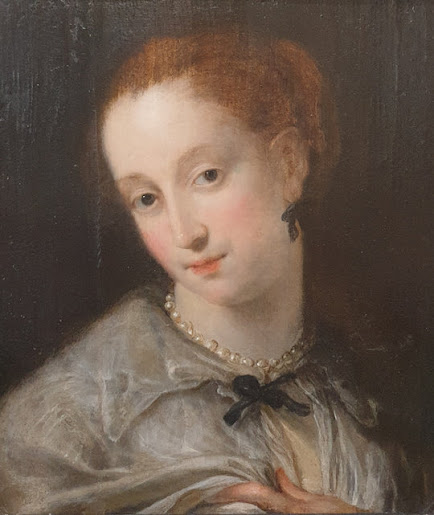Mourning Jewellery: Majestic, Mystic or Sentimental?
Mourning jewellery is often described as sentimental. But jewellery and the changes in its fashion is also a manifestation of the prevailing social etiquette and how changes in social values transform people's perception of beauty and elegance.
There was a profound shift in jewellery in the early 19th century, which sees a move away from a fashion dominated by diamonds often mounted in silver, to elaborate pieces of naturalistic jewellery, pieces inspired by archaeological objects and items mounted with precious and semi-precious stones, where the focus is human hair. Medieval and Renaissance designs are reworked into large pieces of jewellery balancing the crinoline and the heavy fabrics of women's clothing. Advances of techniques in the 17th and 18th centuries, such as the brilliant cut, saw diamonds sparkle in the candle light. But political and socio-economic changes put an abrupt end to their usefulness and desirability for a short while.
That was the background when mourning jewellery came into prominence in Europe, though it had already been in existence since the seventeenth century. Now Europe was coming out of the Napoleonic Wars and was starting to develop heavy industry at a fast pace. These changes transformed people's everyday lives, and gave new opportunities and new wealth.
But it was a material change that had far reaching emotional effects of loss and disillusionment, as people were trying to absorb everything that was going on around them. It created a reaction to Classicism and religious non-conformity. In an effort to swing back to the ideals of the High Church and Anglo Catholic values, inspiration for style and design in jewellery, as in other fields, was sought from the past.
Social mobility was accelerated and jewellery that denotes sentiment and a place in society became more appropriate. In England mourning jewellery reached the height of popularity with Prince Albert's death. Hair often became the primary motif in mourning jewellery because it is seen as the most delicate and lasting material and a reminder of life and death. Hair was woven and knotted to make brooches, lockets, rings, earrings, necklaces and items that had hair worked into the design were suitable for half-mourning.
These objects are material evidence that the person who died is still remembered and is part of the living, and as 'memento mori' for those alive, they are reminded of their own mortality. Mourning jewellery are extraordinary because they serve a social purpose, and are a reminder of past social values. They are also loaded with symbolism and originality by creating a new language of love and memory made up of elaborate design, precious and semi-precious stones, metal and organic material.
Victorian Jet Necklace with Five Shell Cameo Pendants of Classic Females.
From Aurum.
There was a profound shift in jewellery in the early 19th century, which sees a move away from a fashion dominated by diamonds often mounted in silver, to elaborate pieces of naturalistic jewellery, pieces inspired by archaeological objects and items mounted with precious and semi-precious stones, where the focus is human hair. Medieval and Renaissance designs are reworked into large pieces of jewellery balancing the crinoline and the heavy fabrics of women's clothing. Advances of techniques in the 17th and 18th centuries, such as the brilliant cut, saw diamonds sparkle in the candle light. But political and socio-economic changes put an abrupt end to their usefulness and desirability for a short while.
Mourning Brooch with Hair
From Ting's Jewellery Box
That was the background when mourning jewellery came into prominence in Europe, though it had already been in existence since the seventeenth century. Now Europe was coming out of the Napoleonic Wars and was starting to develop heavy industry at a fast pace. These changes transformed people's everyday lives, and gave new opportunities and new wealth.
Antique Amethyst on Ivory Ring
From Charlotte Sayers and Michele Rowan
But it was a material change that had far reaching emotional effects of loss and disillusionment, as people were trying to absorb everything that was going on around them. It created a reaction to Classicism and religious non-conformity. In an effort to swing back to the ideals of the High Church and Anglo Catholic values, inspiration for style and design in jewellery, as in other fields, was sought from the past.
Victorian Cameo Carving of Grecian Style set in Hand Carved Jet Pendant
From Linda Bee
Social mobility was accelerated and jewellery that denotes sentiment and a place in society became more appropriate. In England mourning jewellery reached the height of popularity with Prince Albert's death. Hair often became the primary motif in mourning jewellery because it is seen as the most delicate and lasting material and a reminder of life and death. Hair was woven and knotted to make brooches, lockets, rings, earrings, necklaces and items that had hair worked into the design were suitable for half-mourning.
Large Vintage Black Heart Pendant, French Jet, C1940s
From Linda Bee
These objects are material evidence that the person who died is still remembered and is part of the living, and as 'memento mori' for those alive, they are reminded of their own mortality. Mourning jewellery are extraordinary because they serve a social purpose, and are a reminder of past social values. They are also loaded with symbolism and originality by creating a new language of love and memory made up of elaborate design, precious and semi-precious stones, metal and organic material.
Victorian Pique Brooch, C1870
Edwardian Parkesine hand with wreath brooch
From Ting's Jewellery Box
Victorian Locket with Enclosed Miniature Painted Photograph
From Ting's Jewellery Box
For more information visit www.graysantiques.com
From Ting's Jewellery Box
Victorian Locket with Enclosed Miniature Painted Photograph
From Ting's Jewellery Box
For more information visit www.graysantiques.com
Written by Titika Malkogeorgou








.jpg)

Comments
Post a Comment